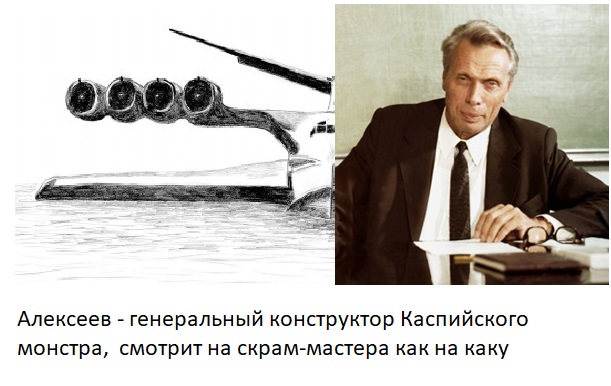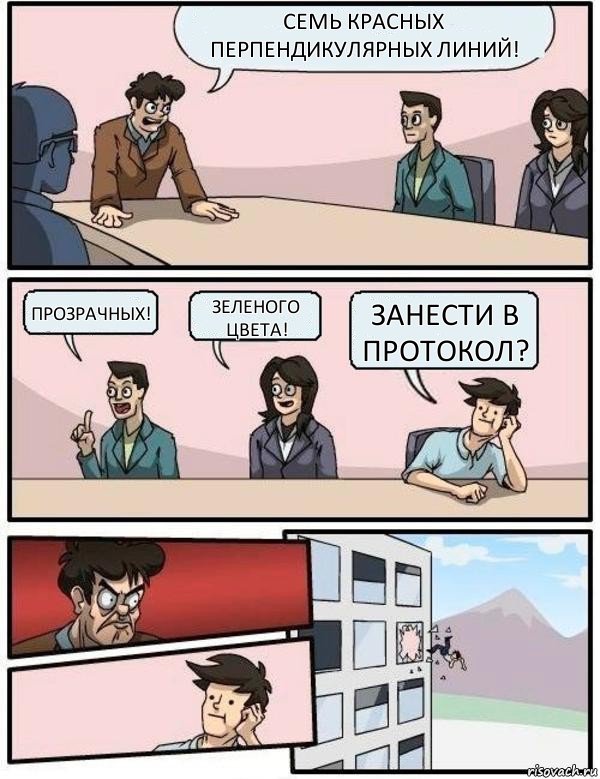
The Caspian Monster was a Soviet ekranoplan that weighed 544 tons, making it the heaviest aircraft in the world. Made from scratch in two years. Think about it while uploading a landing page for selling panties for “just” six months.
I would like to tell you about some of the techniques of the ancient (pre-scrum period) management, which made it possible to achieve such results. To lift an iron bandura the size of a Khrushchev into the air on a new principle and disperse it to five hundred kilometers per hour, for me, is a more creative and technically difficult task than opening another online store, so it may be worth adopting the experience of your ancestors.
Most programmers (myself included) treat meetings as a waste of time, and it really is. Any meeting held without rules has only one positive effect - the eyes are resting from the screen, and the brain from sagging.
Nevertheless, the meeting is the most important thing in the work, because it is at it that decisions are made on the direction of further development and solving complex problems.
It doesn't matter how mega-functional and super-microservice you miss, if you miss absolutely unnecessary nonsense.
10 years ago I worked for a highly authoritarian company where the director and owner was a smart, tough guy who built a half a billion dollar company from scratch in 6 years. Believe me, he knew how to convey his thoughts and make people work, otherwise he would not have been able to build three factories by the age of 30.
Once I was summoned to a three-week coaching in order to make me the most effective manager (and also punish me with exile to Eburg for my $ 19 million). The coach was a girl who silently sat in the corner for the entire meeting, but after the meeting handed out A4 papers to everyone, including the director.
There were two questions in total:
“1. What should I personally do after the meeting?
”“ 2. What orders should others do. "
And then she compared the written answers of all those present. There were a minimum of coincidences! Nobody understood anything, forgot or thought what the other would do.
It was a lifelong lesson. By the way, try again.
This is how the training on conducting effective meetings began, and I will tell you the brief rules of the meeting so that it is effective and interesting.
Meeting rules:
1. AGENDA
The meeting must have an agenda. The agenda should be sent out in advance (at least one day in advance), and there should be a list of issues to be discussed. Ideally, the agenda is a ready-made meeting minutes, only without signatures. A competent, well-formulated agenda will reduce the meeting to a minimum, and possibly cancel it.
Firstly, the agenda will allow you to think over some questions in advance, get ready: take reference data or call a spot specialist with you. You have never had that you are leaving the meeting and only then do you understand what needed to be said, and is it too late?
Secondly, it will allow not to reschedule the meeting, because one of the participants does not remember the number of servers and their capacity.
Thirdly, I, for example, am slow-witted and it is ineffective to shroud me with sudden questions. In the worst case, I will nod and agree, at the best I will ask for time to think. Clever thought comes after.
2. CHAIRMAN The
person who does not let the meeting turn into a doctor and makes sure that it does not deviate from the agenda. You cannot discuss an issue if it is not on the agenda, because people are not ready.
The chairman also instructs the secretary to complete the minutes. Now he is fashionably called a moderator.
3. SECRETARY
The most important person in the meeting. He prepares the agenda and minutes of the meeting.
Suddenly, the position of I. Stalin at the zenith of his career - "Secretary". And yes, this is not the girl who wears coffee and makes sure that the toilet paper does not run out.
The secretary who prepares the agendas of the central committee of the Communist Party is the most influential person on the planet. It depends on him whether the issue of the use of the atomic bomb will be included in the agenda of the meeting.
The secretary may simply not include any issue on the agenda and put this issue on the back burner. Let me give you an example: Vasya and Petya took a shit about rewriting the lendosik from react to angular. If the secretary wants to leave it on react, he simply does not include the question on the agenda and the site remains on react. If he wants it at the Angular, he includes it on the agenda, a stormy shit flares up at the meeting, where it is not clear who is right, and the secretary writes in the PROTOCOL, “It was decided to transfer to the Angular.” If there are several questions at the meeting, then he can ride on the sly , Constitution!)), And if not, then Petya will have to pucker in front of the big director to change an item in the minutes of the meeting.
4. PROTOCOL
Meeting is the process of agreeing and signing the minutes of the meeting. The minutes are the most important thing in the meeting! All this is for his sake, not for the sake of a merry brat in an air conditioned room. The minutes are made on the basis of the agenda.
If, based on the results of the meeting, the protocol was not signed, made or agreed upon, then it was not a meeting, but friendly gatherings.
The protocol allows you to formulate the thoughts voiced at the meeting and turn them into solutions. It's responsibility and lack of confusion. No one is interested in your thoughts if they cannot be entered into the protocol. You have a goal - you are discussing the wording in the protocol. "Transfer the lendosik to react on February 1 and make Vasya responsible."
The minutes can be sent to people who, for one reason or another, were unable to attend the meeting. Moreover, the protocol is a proof that you can and should refer to. Here is a piece of paper, it says "translate to react" and 90% for.
At the end of the meeting, all those with powers vote to adopt the protocol. For all at once (hello, the Constitution!)) Or on separate items.
5. RESULTS
It was great. Meetings turned from useless chatter to work. It made sense, felt the effectiveness and the fact that some decisions are being made.
The number of meetings has decreased, the duration of meetings has decreased. The stupid, but loud-mouthed ones shut up, including myself;) Those who previously seemed quiet and unnecessary turned out to be necessary and smart, and the loud and important ones turned out to be windbag.

6. WHY DOES NOT RISE
A king naked? The minutes of the meetings desperately record your and others' stupidity. It's offensive. And if your boss is dull, he will very soon get sick of being poked at his stupidity.
Suddenly it turns out that he changes his decisions weekly, that it was he who insisted on the decision that led to losses in the millions of rubles.
The protocols begin to be sabotaged, those who insist on their creation are called bureaucrats and “damn it, we just need to cough up a question”.
Previously, the boss declared, demanded, called out and “I didn’t say that, I had to listen with my ears,” but now the protocol is signed on a common server and people poke and laugh with their fingers. Pichalka.
As a result, one protocol turned into a meme, the protocols were no longer shared (secrecy!), People began to refuse to attend meetings where the protocol would be. Everything died. Long live the merry fellows during working hours again!
I have a managerial orgasm at the word “meeting minutes,” but in the last 10 years, it’s only me. You can call it whatever you like, the rally's feedback or something else, but I never had that sweet sensation of a constructive effective meeting, as it was when taking minutes at any modern sprint rallies.